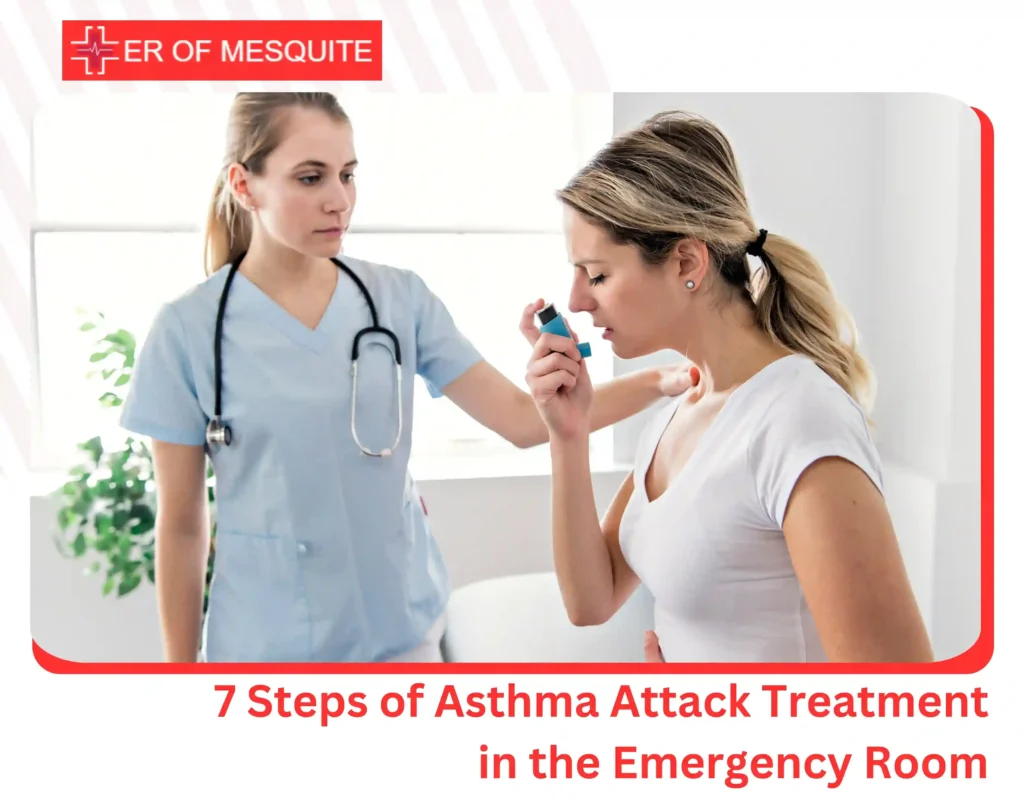One moment you’re breathing normally, and the next, you’re fighting for air. That’s how asthma attacks surprise you. While these episodes are frightening, having a clear asthma attack action plan helps you manage asthma effectively.
In Mesquite, where allergies and seasonal triggers are all too common, having proper knowledge of asthma attack treatment is essential. We’ve put together crucial tips on how to recognize the signs of asthma attack, manage the symptoms, and prevent future flare-ups.
What Is an Asthma Attack?
An asthma attack is the worsening of asthma symptoms. If you have asthma and something like pollen or pet dander triggers your lungs, they react. The muscles around your lungs tense up, and they produce more mucus than usual. All this extra mucus and inflammation block your airways, making breathing tough and causing attack.
Signs of an Asthma Attack
Here’s what you should look for to identify an asthma attack and act fast:
Mild Symptoms
- Frequent coughing, especially at night
- A tight feeling in your chest
- Shortness of breath
Severe Symptoms
- Rapid breathing and wheezing
- Difficulty speaking
- Blue lips or fingertips
- Inability to breathe
If the symptoms are mild you may treat it at home following the asthma action plan prescribed by your doctor. If you notice severe symptoms of asthma, head to the emergency room immediately.
Asthma Attack Treatment & Management at Home
If an asthma attack strikes you or a loved one, here’s what you have to do at home:
- Stay Calm: It’s important to remain calm during an asthma attack because anxiety and stress can make symptoms worse.
- Sit upright: Avoid lying down or bending over, as this can make breathing harder.
- Use a Rescue Inhaler: Take a slow, deep breath while pressing down on the inhaler, and hold the medication in your lungs for 10 seconds. Exhale slowly. Wait a minute between puffs if a second dose is needed.
- Monitor Symptoms: If your asthma symptoms don’t improve after all this, go to the nearest emergency room.
- Follow Your Asthma Attack Action Plan: If you’ve worked with your doctor to create an asthma attack action plan, now is the time to use it. This plan should outline your specific steps based on the severity of your symptoms.
What Is an Asthma Attack Action Plan?
An asthma action plan allows you to monitor your asthma symptoms in an easy-to-follow format. It helps your caregivers assess your situation better and manage your flare-ups easily. The asthma action plan form has three zones to indicate the severity of symptoms. These include:
- Green: This is where you are feeling good with no asthma symptoms. Keep taking your daily control medicines even if you’re feeling fine.
- Yellow: The yellow zone indicates that you are experiencing symptoms of an asthma attack. At this point increase your medication or use your quick-relief medicine.
- Red: The red zone indicates a severe asthma attack with symptoms like shortness of breath, and chest tightness. It is time to go to the nearest emergency room.
Get Expert Asthma and Allergy Treatment in Mesquite
7 Steps of Asthma Attack Treatment in the Emergency Room
If your symptoms do not respond to inhalers and medicines, it’s time to head to the ER. Here’s what happens when you get to the ER of Mesquite for asthma attack treatment:
1. Assessing your Condition
Our doctors will quickly check your breathing, oxygen levels, and how you’re holding up overall. They’ll compare your condition with an asthma action plan to decide on the right treatment.
2. Oxygen Therapy
Severe asthma attacks can cut off oxygen supply. If the doctor sees signs of too little oxygen, they’ll administer it via cannula, face mask, or tracheotomy tube. This helps relieve the strain on your lungs and improves breathing.
3. Tests
To figure out how serious your asthma attack is and rule out other issues, doctors may run a few tests:
- Pulse Oximetry: A pulse oximeter measures oxygen levels in the blood. A normal blood oxygen level is around 95% or higher, lesser levels need oxygen supplementation.
- Chest X-ray: Chest x-ray check for potential complications associated with asthma attacks such as lung damage, pneumonia, pneumothorax, or heart failure.
- Peak Flow Measurement: Peak expiratory flow (PEF) is a small device you blow into to check how fast you can breathe out. Readings in the 80–100% range mean your breathing is on track. If it drops to 50–80%, it’s a sign your asthma is getting worse, and less than 50% signals a medical emergency.
4. Quick-relief medicines
Quick-relief medicines for asthma attack treatment include bronchodilators that quickly relax the muscles around your airways. These medicines are inhaled through an inhaler or a nebulizer to rapidly reach your lungs. They work quickly, usually within 15 to 20 minutes, and last for four to six hours.
| Note: Always consult your healthcare provider for personalized and proper medication use. |
5. Corticosteroids
Inhaled corticosteroids are available as an aerosol liquid, powder, or suspension. You can use it regularly to reduce the number and severity of asthma attacks. Oral corticosteroids are in pill or liquid form, used for a limited time to treat severe asthma attacks.
6. Intravenous Medications
When inhaled therapy fails, intravenous medications are administered to relieve bronchospasm by relaxing bronchial smooth muscle.
7. Follow-Up
After the initial treatment, you may need to stay in the ER for follow-up care so the medical team can monitor your breathing and ensure your symptoms are under control.
Final Thoughts
Asthma attacks don’t have to take you by surprise. With a solid asthma action plan and access to reliable emergency care, you can get the right asthma attack treatment. Mesquite residents, remember that help is always nearby. Stay proactive, and breathe easy.
FAQs
1. How often should I update my asthma attack action plan?
You should check in with your doctor about asthma symptoms every 6 months for kids and once a year for adults. Update your asthma action plan whenever your symptoms or triggers change.
2. How to manage asthma without an inhaler?
The first thing to do is stay calm. Breathe in through your nose and exhale slowly through pursed lips to open your airways. Avoid your triggers and sit upright to make breathing easier. Inhaling steam from a bowl of hot water or a steamy shower can help relax your airways. Sipping something warm like tea may also soothe irritation.
3. What is asthmatic bronchitis or bronchitis asthma attack?
Asthmatic bronchitis is a respiratory condition that occurs when asthma and acute bronchitis occur at the same time. Bronchitis is the inflammation of the bronchial wall. This inflammation makes the airways even more sensitive, leading to frequent or severe asthma attacks.



